Crystals
 Crystal healing, put simply, is the belief that rocks and minerals have supernatural properties, normally properties that are beneficial to the user.
Crystal healing, put simply, is the belief that rocks and minerals have supernatural properties, normally properties that are beneficial to the user.
Crystal healing is an ancient and widespread belief, found in a variety of unconnected cultures. Ancient Egyptians valued lapis lazuli, for example, for its ability to protect those in the afterlife. The Ancient Greeks coined the word “amethyst” from “ἀμεθύω” in reference to its purported abilities to help with intoxication. In the medieval era, writers mentioned crystals in reference to the Abrahamic God, many of them invoking God’s power to cause the crystal’s magical effects. Both pagan and Christian authors believed these things from the ground held some mystical, otherworldly power, and even continuing today, the New Age movement purports that crystals can do as little as bring happiness, or as much as cure cancer, and many eschew conventional medicine in favour of a natural “alternative.”
What is a Crystal?
A “crystal” in a scientific sense is a solid material whose atoms, molecules, or ions, are ordered in a crystal lattice. A crystal lattice is a particular structure where those molecules are highly ordered into a particular structure (fig. 1). A crystal is not just any rock, and many “crystals” are anything but. For example, the silicon and oxygen atoms in quartz are organized in a hexagonal way, and this structure is consistent and repeated throughout the entire quartz. Opal is made out silicon and oxygen like quartz, but it lacks this crystal structure, referred to as amorphous (fig. 2). While quartz and opal are made from the same atoms, their formation leads to their particular effects.
Medieval and ancient authors far preferred the term “stone” over “crystal,” with “crystal” being favoured within the modern New Age. "Crystal" will be the preferred term in this article.
Beliefs Surrounding Crystals
Medieval belief was predicated on the crystals being connected to God. Modern Christians seem to be torn on this interpretation: some believe that crystal healing is paganism and idolatry, while others view crystal healing to be compliant with what God sets out for humanity to do in the Bible, that of enjoying His gifts and reminding the Christian of God’s creative power.
However, the main proponents of crystal healing is the New Age movement, which appeared some time in the 70s and 80s. My earliest sources, Healing Stoned (1981) and Crystal Enlightenment (1985), fall within this time period. Healing Stoned states that no crystal physically works on the body, but the “frequency and magnetic field” from said crystal can affect the physical body. It also describes crystals to be a “living, vibrating, essence of molecules,” as well as warning against using them for ill, as it mentions the mythical city of Atlantis, whose fall was exacerbated by using crystals for evil.
Crystal Enlightenment builds on this idea, including the popular notion of the atoms of crystals being “not really matter at all, but subtle vibrations, each being attuned to the cosmic force.” It further elaborates on the fall of Atlantis being pivotal to the spread of crystal healing, as the refugees fleeing settled in Egypt, South America, and Tibet, which then spread the thought further throughout the world. “The power and potential of crystals cannot be overstated,” Raphaell writes, “It is one of the main contributors to the New Age.”
Efficacy of Crystal Healing
Crystal healing is widely accepted to be pseudoscience. While research on the topic is little, what does exist points to crystal healing being, at best, born of placebo. A placebo is any material who has no physical effect, but still provides some relief.
In 2001, Christopher French, head of the anomalistic psychology research unit at the University of London, along with some colleagues, presented a paper to the British Psychological Society Centenary Annual Conference about a study about crystal healing. In the study, eighty participants were asked to meditate for five minutes, with one group being given a real quartz crystal, or a fake. Half of participants were primed, being told to notice any strange effects the crystal would have on them. After meditating, they were asked about what, if any, effects they experienced. Regardless as to if they had the real or fake crystal, participants reported a warmth in their hands, as well as an increased feeling of well-being. Those who were primed on any possible effects felt these effects stronger, without any change between the quartz and the fake. Those who believed in the power of crystals, measured by a questionnaire, were twice as likely to report feeling effects at all.
Placebo can still be powerful, even if someone is aware that any effects could be placebo. Crystal healing may help some people, especially pertaining to psychological issues, but is not proved to be a proper replacement for conventional medicine.
A Selection of Crystals and Meanings
I have compiled a list of crystals commonly mentioned in ancient, medieval, and modern times, along with their prescribed properties.
Modern: Mentions multiple types. A slow and behind-the-scenes stone, agates promote stability, composure, security, self-confidence, mental clarity, and overcoming negative emotions. It is also said to help with pregnancy, postpartum depression, and lactation. It is good for travels and protects against falling objects. Agates give physical strength and endurance, as well as stabilizing overactive imaginations and helping with multitasking. Agate is technically a type of chalcedony, itself a form of cryptocrystalline quartz, described below, and is named for the Achates river in Italy. It is primarily made of length-fast chalcedony, as opposed to length-slow, which are differentiated based on how the molecules are stacked. Agate is slightly porous, leading to dying it being a widespread practice. Agates are not simply "banded chalcedony," but is defined by its banding patterns, of which agate is well known for: wall-lining banding, which appears like onion-like patterns; and horizonal or Uruguay-type banding, where the patterns are linear. Because of the wide variety of agates, there are just as many trade names for agates, listed here. Refer to the Clear Quartz section for information on how to store and clean. Modern: Amber works with positive and negative forcefields, and whatever life is found within it contributes to its unique energy. It draws out negative energies from the body. It is noted to help with anxiety, depression, and suicidal thoughts, as well as attracting love. Amber promotes manifesting and cleansing the chakras. Physically, amber helps with the endocrine system, liver, kidneys, bladder, and stomach, as well as promoting fertility and vitality. Healing Stoned says that amber helps the Earth rotate. Amber is fossilized tree resin, and is not a crystal. Amber is distinguished from other hardened or fossilized tree resins is its composition. The mark of true ambers lies in polymerization, where the molecules of the amber link together to make longer molecules, a process which takes from ten thousands of years up to millions of years. After being polymerized, the amber becomes harder and less soluble in water, behaving more like a proper rock. Younger resins are called "copal." Modern: Amethyst is a cleanser and spiritual stimulant that is good for mediation, healing, and purifying. It is said to be useful for grief, stress, negative thoughts, and insomnia, with the ability to help with nightmares mentioned multiple times. Amethyst is mentioned to bring focus, success, humility, willpower, creativity, and passion, as well as developing intuition and psychic abilities, confers spiritual wisdom, and purifies the aura. It is reputed to heal nervous system conditions, as well as headaches, migraines, and eyestrain. Healing Stoned mentions that amethyst has "certain frequencies" that are disturbing to those with psychosis, schizoid, paranoia, and "severe neuroses," but can calm catatonia and bipolar. It further states that amethyst, in the future, will be used for surgery, "operating a bit like the laser beam used now but with much less destruction." Amethyst is a variety of quartz that owes its colour both to irradiation and the presence of iron atoms within the crystal lattice. The irradiation causes the iron to lose an electron and bond with oxygen, which causes it's purple colour. This property is also responsible for amethyst's sensitivity to light and heat: amethyst bleaches in sunlight due to UV/ radiation; and heat causes the colour to change, most commonly to yellow or brown, though other colours have been made. Most citrine on the market is, in fact, heat-treated amethyst, since real (amethyst heated in the Earth rather than in the lab) citrine is rather rare. Amethyst is pleochroic, meaning depending on the angle that light hits it, it can display different colour. Refer to the Clear Quartz section for information on how to store and clean. Amethyst should be kept out of sunlight, as it can make the colour fade. Modern: In the modern world, beryls are more commonly referred to by their type, rather than as a group. Beryls are comprised of emeralds, aquamarines, morganites, goshenites, heliodors, and bixbites. Refer to this article for how to clean beryl. Modern: Carbuncle is an archaic term for any brilliantly red stone. Though not sure what exactly it could refer to, it is thought to include rubies, garnets, and spinels. In modern usage, carbuncle has been restricted to red garnets such as almandine and pyrope. Refer to garnet or ruby/sapphire for instructions on how to clean and store. Modern: Carnelian protects against accidents, as well as protecting houses from theft, fires, and storm damage. It is also good for romantic and sexual issues, such as sexual anxiety, impotency, fertility, and conception, as well as possibly being useful for reigniting faded passions in a otherwise loving relationship. Carnelian is also mentioned to be a good stone for PMS, as well as helping with liver, bladder and kidney issues. Carnelian deepens concentration, bringing ambition, courage, and motivation, as well as calming anger. Carnelian is a type of chalcedony, likely named for colour it shares with the cornel cherry. Sard and carnelian are often used as synonyms, but sard is often thought to be harder and darker than carnelian. Refer to the Clear Quartz section for information on how to store and clean. Modern: Chalcedony is great for bringing happiness, absorbs negativity, and relieves one of negative emotions. It is mentioned to be good for groups, promoting group stability and alleviating hostility. Chalcedony is a form of microcrystalline quartz, where the quartz crystals themselves are microscopic. Refer to the Clear Quartz section for information on how to store and clean. Modern: Cinnabar stimulates dignity, vitality, and power, as well as attracting abundance and money. This makes it very beneficial for businesses and finance. Cinnabar is good for sexual dysfunction and infertility, as well as being good for blood disorders and treating infections, as well as extracting energy blockages. Cinnabar crystals are rare, preferring to form in masses or crusts. As it is made of mercury, cinnabar is toxic, and should not be used for things such as crystal elixirs. Modern: An all-purpose and versatile stone, clear quartz is said to be a master healer and an amplifier of energies. It is said to strengthen and heal the auras of "mental and emotional aberrations," helps with concentration, protects against negativity, helps with sleep, and generally aids with any spiritual activity. Clear quartz is often use to cleanse, open, activate, and align chakras. Known to absorb energy readily and easy to program, clear quartz should be cleansed frequently. It is mentioned to cancel out the harmful effects of radiation. Quartz is one of the most common minerals found in the Earth's crust, with pure varieties being colourless, transparent, and hard. Clear quartz is macrocrystalline, where the crystals or grains are visible by the naked eye. Compare with microcrystalline, where the quartz crystals are compact and small, such as with agates. Quartz is made up of helical chains of silicon and oxygen, much like DNA, and quartz can be further divided into left and right-handed quartz depending on how those helices are structured. Quartz is chemically inert and doesn't require any special attention for storing. Different varieties of quartz may have different sensitivities to different cleaning procedures. Please see this article for more information on cleaning quartz. Modern: Coral is a stimulant and tonic for the bloodstream, and helps dissolve calcification in the joints. It is also said to help with visualization. Coral is made from the skeleton of Anthozoans, made primarily of calcium carbonate. They form hard, orange-red branches that have been prized for jewelry. Modern: Diamond is considered to be a conductor and amplifier of energy, more so than clear quartz. It absorbs energy; relieves fear, anxiety, and hallucinations; as well as clearing rooms of unwanted energies. Healing Stoned warns that a diamond's energy is as potent as it is for good, as it is for bad: it mentions that it can cause cancers if used for malicious purposes, and states "no one dies of diamond poisoning[;] it is the poisons already within the mind and heart that can cause … catalytic and sometimes catastrophic rebounds. It is the extreme negative thinking and activity that warps the energy flow." It further states that diamond can heighten the effects of other stones, and its effects and power depend on the size of the gem itself. Diamonds are the hardest natural substance known, a property known since Ancient Greece. Their price is mainly due to advertising and intentional supply withholding; diamonds are common. Graphite is made of pure carbon like diamond, but the difference between them is how their atoms arrange: graphite arranges in a hexagonal pattern, while diamond arranges in an isometric pattern. Due to diamond's natural hardness, cleaning them is not difficult. Refer to the Clear Quartz section for information on how to store and clean. Modern: Emerald's frequencies are never harmful and are good for reviving passions. It is thought to bring self-esteem and focus, invigorating effects on thoughts and philosophy, calms emotions, helps creativity, and strengthens recall of facts and memory. Emeralds can also help with psychic abilities. Emeralds are also thought to help with illnesses, especially those of the liver, lungs, heart, and spine, as well as providing support for chronic illnesses. Emeralds are thought to be good for claustrophobia and legal affairs. Emerald is a variety of beryl whose colour is caused by trace amounts of trivalent chromium or vanadium. Emeralds typically have inclusions and fractures, and are commonly impregnated with oils to hide them. Refer to the beryl section for instructions on cleaning and storing. Modern: Garnet is thought to balance and cleanse energies, bringing passion or peace when needed. is is also good for sexual and romantic issues, as it is said to stimulate sexual hormones, balance and encourage sex drive, and inspire love. More broadly, garnets are good for all kinds of relationships, encouraging commitment, devotion, and loyalty, and is mentioned as a special aid for business relationships. It is said to help with arthritis, rheumatism; and calcification, swelling, and inflammation of the joints. There is no one type of garnet; instead, garnet refers to six minerals: almandine, pyrope, spessartine, andradite, grossular, and uvarovite. All share the same isometric structure, as well as the same amount of silicon and oxygen, but have different combinations of atoms beyond silicon and oxygen. Almandine is the most common garnet. Refer to this article for information on cleaning and storing. Modern: Hematite helps absorb negative energy, brings calm and protection, and helps to ground oneself, as well as protecting against "geopathic stress" and "electromagnetic smog." It is mentioned to be helpful for the liver and blood. Hematite is said to be useful in legal situations. Hematite gives self confidence and cooperation in relationships Hematite is an analogue of corundum. Where iron is in hematite, there is aluminum in corundums. Refer to this article for information on cleaning and storing. Modern: Jasper is thought to be good for quitting addictions, especially alcohol and smoking. It is known as the "supreme nurturer," being highly protective and grounding. Jasper promotes courage, quick thinking, creativity, imagination, confidence, focus, organization, and motivation. It alleviates stress and worry, induces tranquility, banishes harmful thoughts and nightmares, and may promote dream recall. Jaspers are thought to absorb frequencies readily, especially negative ones, stabilizes the aura, aligns chakras, and facilitates safe astral travel. Jasper is a type of chalcedony, often associated with banded iron formations. Jasper is often striped due to the presence of foreign materials and can often appear with agates and opals. The jasper that ancient and medieval texts refer to is likely a green jasper, over the orange ones we typically associate with jasper today. Refer to the Clear Quartz section for information on how to store and clean. Modern: Lapis lazuli stimulates wisdom, good judgement, intellectual analysis, problem solving, idea creation, and honesty. Its intelligence-boosting abilities were often mentioned, bringing the desire for knowledge, truth, and understanding, as well as aiding learning and enhancing memory recall. Lapis lazuli brings deep connections and harmony to friendships, as well as making speaking easier. It is thought to open ESP centers, is good for the throat chakra, enhances dream work, provides wisdom into "mystical realms" and connections with "spiritual guardians," protects against psychic attacks and negative energies, is good for contemplation and mediation, and acts as a mental and spiritual cleanser. Lapis lazuli may simulate the endocrine, immune, and nervous systems; as well as helping with thyroid issues, headaches/migraines, fevers, and general pain; and may calm autism and ADHD. Lapis lazuli is a metamorphic rock composed of a variety of minerals, and is not a true crystal. Lazurite is a common mineral that is called lapis lazuli, but most true lapis lazulis contain hauyne. Lapis lazuli is rather soft and prone to damage. Refer to this article for information on cleaning and storing. Modern: Magnetite is thought to be able to cure "pre-physical manifestations" of disease. Magnetite is magnetic, and its colour can change from black to brown over time. As magnetite is primarily made of iron, it is prone to rusting. Refer to this article for information on cleaning and storing. Modern: Malachite is thought to clear static or repressed emotion, as well as healing past trauma and old emotional patterns, and stimulates clear thinking. It is said to protect against noise and "harmful rays" from technology, as well as against negative phone calls and e-mails at work. It brings balance and fidelity to relationships. Malachite absorbs energies rather than emits, pulling out negative energies. It is an all-purpose healing stone and purger/healer for the subconscious, as well as clearing and activating all chakras, along with facilitating psychic vision. Curiously, it is said to heal "earth energies" and protect against "radiation, electromagnetic pollution," as well as "radioactivity." Malachite is a good travel stone: it helps overcome fears of flying, jet lag, and protects while on the road. Physically, malachite is said to help with the pancreas and spleen, along with aiding with asthma, arthritis, swollen joints, broken bones, torn muscles, menstrual cramps, and childbirth. Malachite is banded similarly to agates. Due to presence of copper, malachite is toxic if ingested. Do not use for elixirs, and use care when cutting or tumbling it. Refer to this article for information on cleaning and storing. Modern: Onyx keeps senses keen and instincts sharp, and helps to fight fears and deflect negative thoughts and criticism, especially in the workplace. It is said to help with fears of the dark. It aids in the development of emotional and physical strength, fostering happiness, good decision-making, and self-discipline. Onyx is said to absorb and transform negative energy, prevent the drain of personal energy, heals old wounds or past life issues, and is good for both mediation and dreaming. Onyx typically refers to a black and white banded variety of agate. Refer to the Clear Quartz section for information on how to store and clean. Modern: Opal promotes calmness, easing stress and depression. It helps center the mind and prevents racing thoughts, as well as bringing happy dreams. Opal balances mood swings, enhances trust in one's own feelings, and improves memory. However, it can also be used to intensify feelings. It is associated with love, passion, desire, and eroticism, and strengthens all relationships. Opal prevents absorbing other people's energies and works on more than one chakra. It is said to ease birthing and overcome the fears of childbirth, pregnancy, and the early months of an infant's life. Opal is also thought to help with fever and infections. Opal is divided into three classifications: precious, fire, and common. Precious opals are typically made of opal-AG, which Is made of aggregated spheres of amorphous silica and water, and are the most prized due to their strong opalescence, the rainbow effect on their surface when light hits it. Fire opals are brown-orange and transparent, with normal varieties displaying no opalescence, and precious fire opals being opalescent. Common opals are opals that don't display any opalescence. Opals contain water, which can evaporate in the sun or in high heat, causing the opal to crack. Refer to this article for information on cleaning and storing. Modern: Pyrite guards against criticism and manipulation by others, and brings assertiveness. It is good for overworking and stress, bringing vitality, ambition, commitment, and perseverance. It inspires creativity, clarity, focus, and recall, as well as supports the expression of masculinity. Pyrite is said to block "energy leaks" and heals "auric tears," along with physically purifying "systems of the bodies," infections, clears "oxygen in blood," strengthens circulation, and stimulates blood flow to the brain. Pyrite is infamous for appearing like gold, leading to its common nickname of "Fools' Gold." Pyrite slowly oxidises in moisture, releasing sulfuric acid. However, this varies by location the pyrite was mined. Refer to this forum post for information on cleaning and storing. Modern: Ruby supports intellectual pursuits, sharpening the mind and stimulating concentration. It restores vitality and energy, and may calm hyperactivity and balance emotions, although it's mentioned that it can be irritating if the wearer is highly sensitive or irritable. Rubies promote sexuality and sensuality, functioning as an aphrodisiac, deepening a couple's relationship, restoring and maintaining passion in sex, increases chances for conception, and encourages closeness and commitment. Rubies guard against psychic and psychological attacks, and may cause harm similarly to diamonds, as described in their section here. It brings success in conflicts, banishes nightmares, reduces fear of the paranormal and evil, and helps protect the home from fire and intruders. Rubies are said to help with the circulatory system, warm the extremities, fight infections, and help with impotence and infertility. It is mentioned to help with balancing menstrual cycles and perimenopause. Corundum is the third hardest mineral. Rubies are the red variety of corundum, and their red colour is caused by chromium. Refer to this article for information on cleaning and storing. Modern: Sapphires give optimism, calm and focus to the mind, and brings happiness, easing depression, anxiety, and insomnia. They are said to give love, commitment, and fidelity in relationships, but may prolong attachment in the case of a divorce. Sapphires clean impurities in auras, assists with meditation, helps with intuition, boosts psychic and healing powers, and is good for channeling "healing energies from the Angelic Realm or a higher source." It may help resolve legal issues. Corundum is the third hardest mineral. While sapphires are often thought of as blue, any corundum that isn't red (ruby) or orange (padparascha) can be called a sapphire. Blue sapphire's colour is caused by iron and titanium. Refer to this article for information on cleaning and storing. Modern: Sard is said to be the "poor man's carnelian," having the same effects but weaker. Sard is a darker, harder variant of carnelian. Refer to the Clear Quartz section for information on how to store and clean. Modern: Sardonyx stimulates honesty, strength of character, attracting friendship and stability to marriage. It is also thought to prevent crime. Sardonyx is a variety of agate with bands of white and brownish red. Refer to the Clear Quartz section for information on how to store and clean. Modern: Topaz is said to uncover lies and illusions, lifting the mood and getting rid of depression, as well as helping after traumas or nervous breakdowns. It helps bring creativity, honesty, faithfulness, trust, clarity, and logic, as well as amplifying one's own positive traits and self-esteem. Topaz is a stone of love and good fortune, and is said to be great for attracting the right person into one's life. It is mentioned to make tastes more sensitive and improves eyesight. Its power is said to increase from crescent at the lowest and full at the highest, as well as being thought to detect fraud. Topaz comes in a variety of colours, green being the most notable to ancient Greeks and Romans, and golden yellow for medieval and modern people. Topaz is known to not be very tough, and is difficult to properly cut, polish, and wear. Refer to this article for information on cleaning and storing. Modern: Turquoise helps the mind, body, and soul, balancing emotions and relaxing the mind, bringing alleviation from anxiety. It is good for luck, ambition, creativity, and helps overcome writer's block. Turquoise is thought to calm the nerves when speaking in public, promotes leadership qualities, and prevents unwise investments. Spiritually, turquoise is said to be good for the throat chakra, enhances intuition, and helps communicate between physical and spiritual realms. Turquoise helps with respiratory, skeletal, and immune system issues, along with preventing accidents and theft. Curiously, Healing Stoned says that turquoise is "no longer of use," and another source says it reflects the physical health of its wearer. Turquoise is known to be soft and porous, making wearing and handling it difficult. Gloves are advised for handling to prevent it from absorbing sweat and oils. Refer to this article for information on cleaning and storing.Agate (Agathe, Achate), SiO2
 Ancient: Notable for curing spider and scorpion wounds, agates are also used to help epilepsy and "lunacy." Worn against the skin, agates help a person be capable, judicious, and prudent in speech. Multiple varieties are described, with varying healing properties. One brings dreams if placed under a pillow, one helps overcome danger and brings bodily strength, and one helps preserve sight and protects against poison and thirst.
Ancient: Notable for curing spider and scorpion wounds, agates are also used to help epilepsy and "lunacy." Worn against the skin, agates help a person be capable, judicious, and prudent in speech. Multiple varieties are described, with varying healing properties. One brings dreams if placed under a pillow, one helps overcome danger and brings bodily strength, and one helps preserve sight and protects against poison and thirst.Amber (Succinus, Electrum), organic
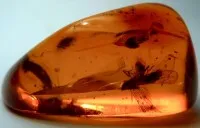 Ancient: There are multiple stories as to amber's origin. Amber is claimed to be good for the tonsils and fauces, as well as "dimness of sight." Said to cure fevers, stomach issues, and other diseases. Prevents delirium and strangery, as well as helping with giving birth. Amber helps keep the wearer chaste. If rubbed, attracts leaves and straws, and if burnt, drives away serpents. It is mentioned to be a common material used to imitate other stones, especially amethyst.
Ancient: There are multiple stories as to amber's origin. Amber is claimed to be good for the tonsils and fauces, as well as "dimness of sight." Said to cure fevers, stomach issues, and other diseases. Prevents delirium and strangery, as well as helping with giving birth. Amber helps keep the wearer chaste. If rubbed, attracts leaves and straws, and if burnt, drives away serpents. It is mentioned to be a common material used to imitate other stones, especially amethyst.Amethyst (Amethystus), SiO2
 Ancient: Amethyst is said to remove face spots, tumors, spider bites, and "noxious spells." It wards of locusts with a spell, assures the access to "the presence of kings," and makes serpents and adders flee. Amethyst counteracts drunkenness and evil thoughts, keeps one awake, and "confers a good understanding of what is knowable."
Ancient: Amethyst is said to remove face spots, tumors, spider bites, and "noxious spells." It wards of locusts with a spell, assures the access to "the presence of kings," and makes serpents and adders flee. Amethyst counteracts drunkenness and evil thoughts, keeps one awake, and "confers a good understanding of what is knowable."Beryl (Beryllus), Beryllos, Be3Al2(Si6O18)
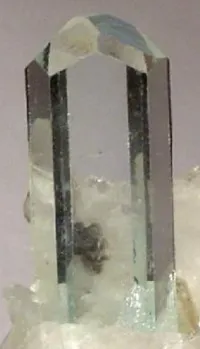 Ancient: Beryls were thought to be of the "same nature" or "closely analogous" to smaragdus (emeralds) by Pliny. They are thought to cure poison if grated in water, as well as helping with liver pain, shortness of breath, belching, and watery eyes. Often holding and looking at a beryl makes one less argumentative and more tranquil, as well as bringing mild manners, cleverness, and resolving marital disputes.
Ancient: Beryls were thought to be of the "same nature" or "closely analogous" to smaragdus (emeralds) by Pliny. They are thought to cure poison if grated in water, as well as helping with liver pain, shortness of breath, belching, and watery eyes. Often holding and looking at a beryl makes one less argumentative and more tranquil, as well as bringing mild manners, cleverness, and resolving marital disputes.Carbuncle (Carbunculus), archaic
 Ancient: There are two varieties of carbuncle: a male and female, whose properties are the exact same, except the female is weaker. Carbuncle dispels any illness or poison in the air, and if of excellent quality, is said to shine in the dark.
Ancient: There are two varieties of carbuncle: a male and female, whose properties are the exact same, except the female is weaker. Carbuncle dispels any illness or poison in the air, and if of excellent quality, is said to shine in the dark.Carnelian (Corneolus, Cornelian), SiO2
 Ancient: Carnelian helps with bleeding, especially with nosebleeds, periods, and hemorrhoids. Carnelian is said to help calm anger.
Ancient: Carnelian helps with bleeding, especially with nosebleeds, periods, and hemorrhoids. Carnelian is said to help calm anger.Chalcedony, SiO2
 Ancient: Chalcedony is mentioned in Natural History, but it's properties are not described. It "turns away infirmaries" and makes the mind strong against wrath if worn touching a vein, and if pierced by emery and worn around the neck, said to be good against depression. If held in one's hand, it is said to bring "consistent ways of speaking" and wisdom.
Ancient: Chalcedony is mentioned in Natural History, but it's properties are not described. It "turns away infirmaries" and makes the mind strong against wrath if worn touching a vein, and if pierced by emery and worn around the neck, said to be good against depression. If held in one's hand, it is said to bring "consistent ways of speaking" and wisdom.Cinnabar (Cinnabaris, Varach, Sanguis Draconis), HgS
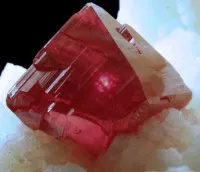 Ancient: Cinnabar is mentioned to be a poison if confused with minium. It is a remedy for any flux, especially of the blood.
Ancient: Cinnabar is mentioned to be a poison if confused with minium. It is a remedy for any flux, especially of the blood.Clear Quartz (Crystal, Crystallus), SiO2
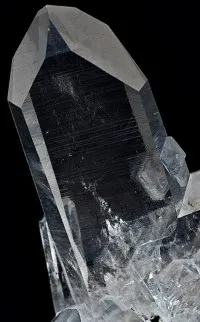 Ancient: Clear quartz was thought to only form in places where snow freezes with the "greatest intensity and said to be a kind of ice needing rainwater and snow to form. This is where the word "crystal" comes from, from Greek "XXXXX," meaning ice. Clear quartz is said to improve vision; swelling on the neck or in the uvula; scrofula on neck; ailments of the heart, stomach, or belly; decreases thirst if place under the tongue; and if powered and mixed with honey, helps with lactation.
Ancient: Clear quartz was thought to only form in places where snow freezes with the "greatest intensity and said to be a kind of ice needing rainwater and snow to form. This is where the word "crystal" comes from, from Greek "XXXXX," meaning ice. Clear quartz is said to improve vision; swelling on the neck or in the uvula; scrofula on neck; ailments of the heart, stomach, or belly; decreases thirst if place under the tongue; and if powered and mixed with honey, helps with lactation.Coral (Curalium), organic
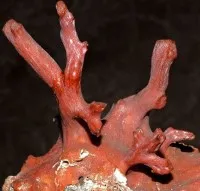 Ancient: Coral is mentioned to protect infants from danger if branches are hung around their necks, which is also the same way it is said to help with epilepsy, menstruation, protection against storms, lighting, and hail. It is good for bleeding, with a special note for powdered coral being well when someone is spitting up blood. If ground up and sprinkled with water on herbs or trees, it multiplies the trees' fruits. Coral is thought to speed the beginning or end of any business.
Ancient: Coral is mentioned to protect infants from danger if branches are hung around their necks, which is also the same way it is said to help with epilepsy, menstruation, protection against storms, lighting, and hail. It is good for bleeding, with a special note for powdered coral being well when someone is spitting up blood. If ground up and sprinkled with water on herbs or trees, it multiplies the trees' fruits. Coral is thought to speed the beginning or end of any business.Diamond (Adamas, Diamant, Anachite), C
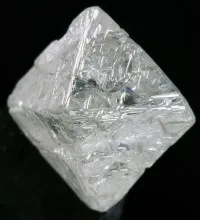 Ancient: Diamond's power is more potent if set in silver, gold, or steel, and is thought to attract iron like a magnet. If bound on the left arm, diamond is said to prove effective against enemies, insanity, wild beasts, "savage beasts," and disputes. Its anti-poison effect is mentioned multiple times, as well as its effects on the mind, mainly dispelling delirium, banishing "phantasms" and "groundless perturbations of the mind," and if placed on the tongue, preventing a person from being malicious or evil. It weakens palsy and apoplexy. Notably, the devil stays away from diamonds because it "withstands his power."
Ancient: Diamond's power is more potent if set in silver, gold, or steel, and is thought to attract iron like a magnet. If bound on the left arm, diamond is said to prove effective against enemies, insanity, wild beasts, "savage beasts," and disputes. Its anti-poison effect is mentioned multiple times, as well as its effects on the mind, mainly dispelling delirium, banishing "phantasms" and "groundless perturbations of the mind," and if placed on the tongue, preventing a person from being malicious or evil. It weakens palsy and apoplexy. Notably, the devil stays away from diamonds because it "withstands his power."Emerald (Smaragdus), Be3Al2(Si6O18)
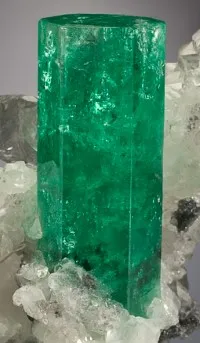 Ancient: See beryl. Emerald is called "smaragdus," but its not clear if it referred to emeralds in specific or any green stone. Emeralds are powerful against all human illnesses, including epilepsy, headaches, and worms. Multiple times it is mentioned to be good for the eyes, including soothing them and strengthening weak eyes. Emerald "will not endure sexual intercourse" and will break upon having sex, along with inclining the wearer towards chastity. Emeralds gives persuasion in speech, prevents storms, and is good for divination.
Ancient: See beryl. Emerald is called "smaragdus," but its not clear if it referred to emeralds in specific or any green stone. Emeralds are powerful against all human illnesses, including epilepsy, headaches, and worms. Multiple times it is mentioned to be good for the eyes, including soothing them and strengthening weak eyes. Emerald "will not endure sexual intercourse" and will break upon having sex, along with inclining the wearer towards chastity. Emeralds gives persuasion in speech, prevents storms, and is good for divination.Garnet (Granatus), (variable)(SiO4)3
 Ancient: See carbuncle. Garnet is thought to bring joy and get rid of sadness.
Ancient: See carbuncle. Garnet is thought to bring joy and get rid of sadness.Hematite (Ematite, Haematite), Fe2O3
 Ancient: Pliny mentions hematite but does not say anything of its properties. Hematite was thought to be a powerful styptic, improved roughness of eyelids, and cures "dimness" of sight. If crushed and drunk with water, hematite helps with flux of the bladder and bowels, menstruation, and bloody saliva. If mixed with wine, it heals ulcers and wounds, as well as helps eats away excess flesh that forms in wounds.
Ancient: Pliny mentions hematite but does not say anything of its properties. Hematite was thought to be a powerful styptic, improved roughness of eyelids, and cures "dimness" of sight. If crushed and drunk with water, hematite helps with flux of the bladder and bowels, menstruation, and bloody saliva. If mixed with wine, it heals ulcers and wounds, as well as helps eats away excess flesh that forms in wounds.Jasper (Jaspis), SiO2
 Ancient: Pliny mentions jasper, but does not describe its properties. However, it is likely he (along with others after him) were referring to green jasper. Albertus Magnus is thought to have called praise, chrysopraise, and possibly jade along with jasper. Jasper helps cure deafness, "commotion of the humours" in many body parts, loosens nasal discharge, helps with bleeding including menstruation, and aids in childbirth. Jasper is thought to be a contraceptive, keeping the wearer from licentiousness, as well as protecting a new mother and her child from being attacked by "malign" spirits. If incantations are recited over it, it makes one pleasing, powerful, and safe, along with getting rid of fevers and dropsy.
Ancient: Pliny mentions jasper, but does not describe its properties. However, it is likely he (along with others after him) were referring to green jasper. Albertus Magnus is thought to have called praise, chrysopraise, and possibly jade along with jasper. Jasper helps cure deafness, "commotion of the humours" in many body parts, loosens nasal discharge, helps with bleeding including menstruation, and aids in childbirth. Jasper is thought to be a contraceptive, keeping the wearer from licentiousness, as well as protecting a new mother and her child from being attacked by "malign" spirits. If incantations are recited over it, it makes one pleasing, powerful, and safe, along with getting rid of fevers and dropsy.Lapis Lazuli (Zemech, Sapphiros), multiple
 Ancient: Pliny mentions lapis lazuli as "sapphiros," something we'd think would apply to sapphire, but at that time, was not. It was taken as a remedy for too much black bile, quartan fever, and for fainting.
Ancient: Pliny mentions lapis lazuli as "sapphiros," something we'd think would apply to sapphire, but at that time, was not. It was taken as a remedy for too much black bile, quartan fever, and for fainting.Magnetite (Magnes, Magnesian Stone, Magnet), Fe2+Fe3+2O4
 Ancient: Magnetite is thought to attract iron, as well as having its magnetism negated if a diamond is placed upon it. While it's mentioned to cure madness or from being "tortured by phantasms," it is also thought to call upon phantoms if "incantations" and "magic signs" are used. Magnetite is also thought to be good against worms, and if put in honey and water, cures dropsy. Curiously, magnetite is also thought to tell the fidelity of a woman. If placed under her pillow as she sleeps, it will either make her run into her lover's arms if loyal, or have nightmares and wake up if not. It is also mentioned to be an aid for thieves, causing nightmares in those sleeping in the house if a thief puts burning coals and magnetite powder in the corners of the house.
Ancient: Magnetite is thought to attract iron, as well as having its magnetism negated if a diamond is placed upon it. While it's mentioned to cure madness or from being "tortured by phantasms," it is also thought to call upon phantoms if "incantations" and "magic signs" are used. Magnetite is also thought to be good against worms, and if put in honey and water, cures dropsy. Curiously, magnetite is also thought to tell the fidelity of a woman. If placed under her pillow as she sleeps, it will either make her run into her lover's arms if loyal, or have nightmares and wake up if not. It is also mentioned to be an aid for thieves, causing nightmares in those sleeping in the house if a thief puts burning coals and magnetite powder in the corners of the house.Malachite (Malochite), Cu2(CO3)(OH)2
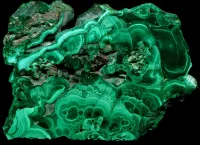 Ancient: Malachite is mentioned to protect the wearer from harm, as well as protecting infants in cradles.
Ancient: Malachite is mentioned to protect the wearer from harm, as well as protecting infants in cradles.Onyx (Onycha, Onychulus, Onychinus), SiO2
 Ancient: Onyx is thought to cure fevers, pains in heart, sides, and stomach, as well as curing disease in cattle. Onyx has both been described as a curer of sadness and depression, as well as an inducer (though this could be cured by using sard). One kind of onyx is thought to be able to be put into someone's eye and not be felt.
Ancient: Onyx is thought to cure fevers, pains in heart, sides, and stomach, as well as curing disease in cattle. Onyx has both been described as a curer of sadness and depression, as well as an inducer (though this could be cured by using sard). One kind of onyx is thought to be able to be put into someone's eye and not be felt.Opal (Opthalmus), SiO2 + H2O
 Ancient: Pliny said that opal "presents the greatest difficulty of description." Opal in other sources was mentioned to protect the wearer from eye disease, but makes everyone around them have worse sight. It is said to be favoured by thieves because this property can make the wearer invisible.
Ancient: Pliny said that opal "presents the greatest difficulty of description." Opal in other sources was mentioned to protect the wearer from eye disease, but makes everyone around them have worse sight. It is said to be favoured by thieves because this property can make the wearer invisible.Pyrite (Virite, Peririte, Perithe),
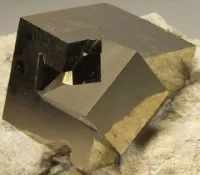 Ancient: There was no mentioned use of pyrite, but multiple sources mentioned that it could burn the fingers of anyone who touches it.
Ancient: There was no mentioned use of pyrite, but multiple sources mentioned that it could burn the fingers of anyone who touches it.Ruby (Carbuncle, Rubinus), Al2O3
 Ancient: See carbuncle.
Ancient: See carbuncle.Sapphire (Saphirus), Al2O3
 Ancient: Sapphire is mentioned to cure abscesses, sties, eye inflammation, and stomach pains, as well as invigorating the body. It brings the wearer peaceful agreements, piousness, and "confirms the mind in goodness," as well as removing wrath and evil spirits. Two interesting properties are noted: giving knowledge and getting rid of unwanted lovers. If someone is a "fool" but wants knowledge, one should rub a sapphire with their tongue while fasting. If put in wine and given to an unwanted lover for three or more days, it will make them lose interest.
Ancient: Sapphire is mentioned to cure abscesses, sties, eye inflammation, and stomach pains, as well as invigorating the body. It brings the wearer peaceful agreements, piousness, and "confirms the mind in goodness," as well as removing wrath and evil spirits. Two interesting properties are noted: giving knowledge and getting rid of unwanted lovers. If someone is a "fool" but wants knowledge, one should rub a sapphire with their tongue while fasting. If put in wine and given to an unwanted lover for three or more days, it will make them lose interest.Sard (Sardinus), SiO2
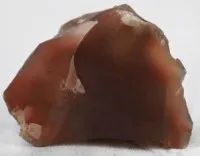 Ancient: Cures deafness bought by illness and cures diseases, as well as helping with childbirth. It brings happiness and sharpens the wits, as well as counteracts onyx's depressive effects.
Ancient: Cures deafness bought by illness and cures diseases, as well as helping with childbirth. It brings happiness and sharpens the wits, as well as counteracts onyx's depressive effects.Sardonyx, SiO2
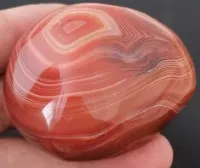 Ancient: If on the mouth or skin, sardonyx strengthens understanding, knowledge, and the senses. If put in the loins, it causes chastity. If worn on a ring, it prevents a disease from coming back.
Ancient: If on the mouth or skin, sardonyx strengthens understanding, knowledge, and the senses. If put in the loins, it causes chastity. If worn on a ring, it prevents a disease from coming back.Topaz (Topazos, Topazius), Al2(SiO4)(F,OH)2
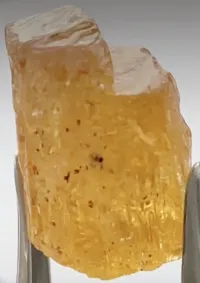 Ancient: Topaz is mentioned in Natural History to be a green stone, which makes "topazos" an unknown. Later sources describe it with the golden-yellow we normally associate with topaz. Topaz is said to stop water from boiling, reflects objects like a mirror, is good for viewing solar eclipses, and sweats when in the presence of poisons in food. It is mentioned to cure fevers, leprosy, spleen issues, hemorrhoids, and "attacks of lunacy." Topaz prevents assaults, and if a special chant is applied to it, banishes evil.
Ancient: Topaz is mentioned in Natural History to be a green stone, which makes "topazos" an unknown. Later sources describe it with the golden-yellow we normally associate with topaz. Topaz is said to stop water from boiling, reflects objects like a mirror, is good for viewing solar eclipses, and sweats when in the presence of poisons in food. It is mentioned to cure fevers, leprosy, spleen issues, hemorrhoids, and "attacks of lunacy." Topaz prevents assaults, and if a special chant is applied to it, banishes evil.Turquoise (Turchois), CuAl6(PO4)4(OH)8 · 4H2O
 Ancient: Turquoise is said to preserve the sights of the wearer, as well as protecting them from misfortune.
Ancient: Turquoise is said to preserve the sights of the wearer, as well as protecting them from misfortune.